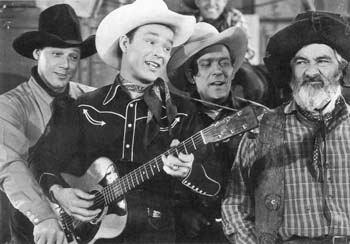Trailhappy
The singing cowboy: Roy Rogers--gone but not forgotten.
Searching for the spirit of Roy Rogers
By David Templeton
IT WAS EARLY in the morning--listening for the weather report on the radio--that I first heard the news: Roy Rogers was dead. At the age of 86, the Singing Cowboy had died of congestive heart failure at his home in Apple Valley, Calif. A big lump began to gather in my throat.
"Wow," I muttered, barely able to say the word. I went looking for my Roy Rogers T-shirt or my Roy Rogers trick pocket knife, something to act as a kind of instant memorial to the quirky, soft-spoken guy who once stood as an international symbol of American decency.
As I set out on my search for Roy Rogers paraphernalia, I recalled another quest--exactly five years ago--for the King of the Cowboys. It began as a hunt through local video stores, inspired by a phone chat with my dad. My father had related his own boyish memory of playing cowboy in his front yard, of going to the movies and paying a quarter to see Roy Rogers onscreen with his "wonder horse" Trigger, of seeing Roy in person riding Trigger in a Fourth of July parade down the center of Dad's hometown of Ontario, Calif.
The picture of my father playing cowboy was an enigma. He'd always seemed so old to me: It was hard to imagine him even playing, harder still to imagine him--a stationery salesman turned purchasing agent--as a cowboy.
Aware of Roy mainly through my father's stories, I was curious to see what the films were like.
Unable to locate any of the movies--"Who's Roy Rogers?" I was frequently asked, though Roy made almost 90 movies and once was the top box-office movie star for 11 years running, from 1943 to 1954--I finally finagled an interview with the man himself.
"What do you got to say?" Rogers asked, talking to me by phone from the office of the Roy Rogers-Dale Evans Museum, in Victorville.
"Where can I find some of your movies?" I asked.
"We got 'em all right here in the gift shop," he said. "Why don't you come on down and see the museum. We got Trigger here, stuffed. You need to see this."
I drove down to Victorville, with Susan, my wife. My father met me at the museum door. For the next few hours, we wandered together through rows and rows of old costumes and castoffs and knickknacks that most people--those without their own museums--tend to throw away.
It was a strange form of bonding, viewing all the bits and pieces of a man's life, a man who was once an inspiration to millions of little boys and girls, and who now was barely remembered by anyone under the age of 40.
"Everything fades," Dad explained, as we stood gazing at the stuffed remains of good old Trigger. "Everything fades." In the gift shop, I bought a few videos, a little cowboy hat, and the Roy Rogers T-shirt. My father and I grinned "Happy Trails," at each other, and Susan and I drove off into the desert.
What occurred then was another kind of search for Roy Rogers.
TRAVELING UP through the middle of California--hard country, ranch country, cowboy country--I stopped often, questioning the shopkeepers, ranch hands, and waitresses along the way. "Tell me about Roy Rogers," I'd say.
"He wore fancy outfits," drawled one well-read cowboy, the ranch foreman at Deep Springs College, in Bishop, an innovative, academically rigorous school/ranch where students alternate their studies with daily chores: milking, roping, slaughtering. "I never knew a real cowboy who'd wear any of that Roy Rogers stuff," he said. "But people saw that and they thought that's what a cowboy was. I'm still trying to live Roy Rogers down, to tell you the truth."
In the Alabama Hills above the nearby town of Lone Pine, we camped on the very same mountain where Roy Rogers had filmed many of his movies. Lone Pine had just seen the completion of filming on Mel Gibson's movie Maverick, shot in those very same hills, and the town was preparing for the annual Lone Pine Film Festival, a celebration of great old-time Western movies.
"Roy is the king," enthused Blackie, proprietor of a video store with a shrinelike section devoted to Roy Rogers' movies. Like me, however, Blackie admitted that his love of the Singing Cowboy was a hand-me- down from his own father. "He saw Roy and Trigger in person once," Blackie proudly said.
"He even had an autographed Roy Rogers comic book."
I finished my journey home, watched my movies, wore my T-shirt, but felt no closer to Roy Rogers, the enigma from a time I never knew. On the other hand, I did feel closer to my father than ever before. Weeks later, I met Thys Ockersen, a Dutch documentary maker who'd made a film--The King of the Cowboys--about his own search for Roy Rogers.
"Roy Rogers will live forever," he explained, in slightly tweaked English, "because our fathers once went to his movies and told us about it. It goes in a circle. By loving the things our fathers have loved, we can hold our fathers even closer."
Makes sense to me.
Long live Roy Rogers.
[ Sonoma County | MetroActive Central | Archives ]
Copyright © Metro Publishing Inc. Maintained by Boulevards New Media.
![]()

Merrick Morton
From the July 9-15, 1998 issue of the Sonoma County Independent.
![[MetroActive Arts]](/gifs/art468.gif)